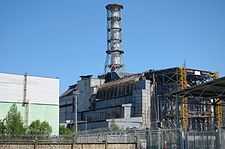Chernobyl Exclusion Zone
| Chernobyl Exclusion Zone (Ukrainian: Зона відчуження Чорнобильської АЕС) | |
| Zone of Alienation, 30 kilometre Zone | |
| Exclusion area and disaster area | |
| Entrance to the Chernobyl Exclusion Zone at Checkpoint "Dityatki" | |
| Official name: Chernobyl Nuclear Power Plant Zone of Alienation | |
| Named for: The Chernobyl Nuclear Power Plant after the disaster | |
| Country | |
|---|---|
| Oblasts | Kiev Oblast, Zhytomyr Oblast |
| Raions | Ivankiv Raion (includes former Chernobyl Raion), Poliske Raion, Narodychi Raion |
| Borders on | Belarus, Polesie State Radioecological Reserve |
| Cities | Chernobyl, Pripyat, Poliske |
| Landmarks | Kopachi, Red Forest |
| Buildings | Russian Woodpecker, Chernobyl Nuclear Power Plant and sarcophagus |
| River | Pripyat River |
| Coordinates | 51°18′00″N 30°00′18″E / 51.3°N 30.005°ECoordinates: 51°18′00″N 30°00′18″E / 51.3°N 30.005°E |
| Area | 2,600 km2 (1,004 sq mi) |
| Population | The Exclusion Zone is an "Area of Absolute (Mandatory) Resettlement".
A few hundred samosely have been permitted to remain. Employees of state agencies are resident in the Zone on a temporary basis[1][2] |
| Founded | 1986 (Current borders as of 1997) |
| Management | State Agency of Ukraine on the Exclusion Zone Management, part of State Emergency Service of Ukraine |
| Government | Government of Ukraine |
| - location | Kiev, Ukraine |
| For public | Not accessible to the public without permission. Permission can be requested in writing in advance[3] or arranged with a tour operator. |
| Timezone | EET (UTC+2) |
| - summer (DST) | EEST (UTC+3) |
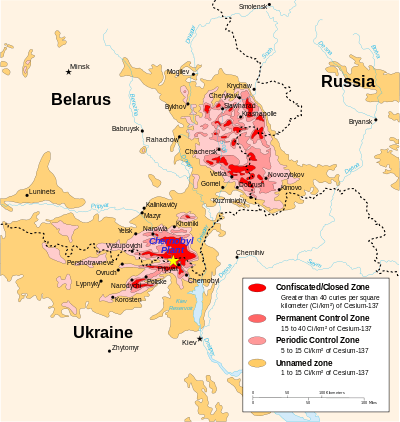 1996 Chernobyl radiation map from CIA - 600 kilometres wide
| |
| Wikimedia Commons: Chernobyl disaster | |
| Website: http://www.dazv.gov.ua/en/ | |
The Chernobyl Nuclear Power Plant Zone of Alienation (Ukrainian: Зона відчуження Чорнобильської АЕС, zona vidchuzhennya Chornobyl's'koyi AES) is an officially designated exclusion area around the site of the Chernobyl nuclear reactor disaster.[4]:p.4–5:p.49f.3 It is also commonly known as the Chernobyl Exclusion Zone, the 30 Kilometre Zone, or simply The Zone[4]:p.2–5 (Ukrainian: Чорнобильська зона, Chornobyl's'ka zona).
Established by the USSR military soon after the 1986 disaster, it initially existed as an area of 30 km radius from the Chernobyl Nuclear Power Plant designated for evacuation and placed under military control.[5][6] Its borders have since been altered to cover a larger area of Ukraine. The Chernobyl Exclusion Zone borders a separately administered area, the Polesie State Radioecological Reserve, to the north, in Belarus. The Chernobyl Exclusion Zone is managed by an agency of the State Emergency Service of Ukraine, while the power plant and its sarcophagus (and replacement) are administered separately.
The Exclusion Zone covers an area of approximately 2,600 km2 (1,000 sq mi)[7] in Ukraine immediately surrounding the Chernobyl nuclear power plant where radioactive contamination from fallout is highest and public access and inhabitation are restricted. Other areas of compulsory resettlement and voluntary relocation not part of the restricted exclusion zone exist in the surrounding areas and throughout Ukraine.[8]
The Exclusion Zone's purpose is to restrict access to hazardous areas, reduce the spread of radiological contamination and conduct radiological and ecological monitoring activities.[9] Today the Exclusion Zone is one of the most radioactively contaminated areas in the world and draws significant scientific interest for the high levels of radiation exposure in the environment, as well as increasing interest from tourists.[10]
Geographically, it includes the northernmost raions (districts) of the Kiev and Zhytomyr oblasts (regions) of Ukraine.
History
Before 1986
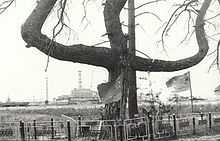
Historically and geographically, the zone is the heartland of the Polesia region. This predominantly rural woodland and marshland area was once home to 120,000 people living in the cities of Chernobyl and Pripyat as well as 187 smaller communities,[11] but is now mostly uninhabited. All settlements remain designated on geographic maps but marked as нежил. (nezhyl.) - "uninhabited". The woodland in the area around Pripyat was a focal point of partisan resistance during the Second World War, experience of which allowed evacuated residents to evade guards and return.[6] In the woodland near the Chernobyl Nuclear Power Plant stood the 'Partisan's Tree' or 'Cross Tree', which was used to hang captured partisans. The tree fell down due to age in 1996 and a memorial now stands at its location.
Setup of the Exclusion Zone
10-kilometre and 30-kilometre Zones
The Exclusion Zone was established soon after the Chernobyl disaster on May 2, 1986, when a USSR government commission headed by Nikolai Ryzhkov[7]:4 decided on a "rather arbitrary"[5]:161 area of a 30-kilometre radius from Reactor 4 as the designated evacuation area. The 30 km Zone was initially divided into three subzones: the area immediately adjacent to Reactor 4, an area of approximately 10 km radius from the reactor and the remaining 30 km Zone. Protective clothing and available facilities varied between these subzones.[5]
Later in 1986, after updated maps of the contaminated areas were produced, the Zone was split into three areas to designate further evacuation areas based on the revised dose limit of 100 mSv.[7]:4
- the "Black Zone" (over 200 µSv·h−1), to which evacuees were never to return
- the "Red Zone" (50–200 µSv·h−1) where evacuees might return once radiation levels normalized
- the "Blue Zone" (30–50 µSv·h−1) where children and pregnant women were evacuated starting in the summer of 1986
Special permission for access and full military control was put in place in later 1986.[5] Although evacuations were not immediate, 91,200 people were eventually evacuated from these zones.[6]:104
In November 1986, control over activities in the Zone was given to the new production association Kombinat. Based in the evacuated city of Chernobyl, the association's responsibility was to operate the power plant, decontaminate the 30 km Zone, supply materials and goods to the Zone, and construct housing outside the new town of Slavutych for the power plant personnel and their families.[5]:162
In March 1989, a "Safe Living Concept" was created for people living in contaminated zones beyond the Exclusion Zone in Belarus, Ukraine, and Russia.[4]:p.49 In October 1989, the Soviet government requested assistance from the International Atomic Energy Agency (IAEA) to assess the "Soviet Safe Living Concept" for inhabitants of contaminated areas.[4]:p.52 "Throughout the Soviet period, an image of containment was partially achieved through selective resettlements and territorial delineations of contaminated zones."[4]:p.49
After Independence

In February 1991, the law On The Legal Status of the Territory Exposed to the Radioactive Contamination resulting from the ChNPP Accident was passed, updating the borders of the Exclusion Zone and defining obligatory and voluntary resettlement areas, and areas for enhanced monitoring. The borders were based on soil deposits of Strontium-90, Cesium-137 and Plutonium as well as the calculated dose rate (Sieverts) as identified by the National Commission for Radiation Protection of Ukraine.[12] Responsibility for monitoring and coordination of activities in the Exclusion Zone was given to the Ministry of Chernobyl Affairs.
In-depth studies were conducted from 1992–93, culminating the updating of the 1991 law followed by further evacuations from the Polesia area.[7] A number of evacuation zones were determined; the "Exclusion Zone", the "Zone of Absolute (Mandatory) Resettlement" and the "Zone of Guaranteed Voluntary Resettlement", as well as many areas throughout Ukraine designated as areas for radiation monitoring.[8] The evacuation of contaminated areas outside of the Exclusion Zone continued in both the compulsory and voluntary resettlement areas, with 53,000 people evacuated from areas in Ukraine from 1990 to 1995.[6]
After Ukrainian Independence, funding for the policing and protection of the Zone was initially limited, resulting in even further settling by samosely (returnees) and other illegal intrusion.[1][2]
In 1997 the areas of Poliske and Narodychi, which had been evacuated, were added to the existing area of the Exclusion Zone and the Zone now encompasses the Exclusion Zone and parts of the Zone of Absolute (Mandatory) Resettlement of an area of approximately 2,600 km2.[7] This Zone was placed under management of the 'Administration of the exclusion zone and the zone of absolute (mandatory) resettlement' within the Ministry of Emergencies.
In 15 December 2000 all nuclear power production at the power plant was ceased after an official ceremony with then-President Leonid Kuchma when the last remaining operational reactor, number 3, was shut down.[13] Power for the ongoing decommissioning work and the Zone is now provided by a newly built oil-fueled power station.
The Exclusion Zone is now evacuated save for a small number of samosely (returnees or self-settlers). Areas outside the Exclusion Zone designated for voluntary resettlement continue to be evacuated.
People in the Zone
Population
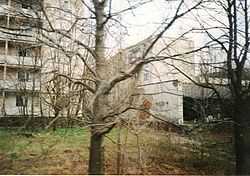
The Zone is estimated to be home to 197 samosely[14] living in 11 villages as well as the town of Chernobyl.[15] This number is in decline, down from previous estimates of 314 in 2007 and 1,200 in 1986.[15] These residents are elderly, with an average age of 63.[15] After recurrent attempts at expulsion, the authorities became reconciled to their presence and have allowed them limited supporting services. Residents are now informally permitted to stay by the Ukrainian government.
Approximately 3,000 people work in the Zone of Alienation on various tasks, such as the construction of the New Safe Confinement, the ongoing decommissioning of the reactors, and assessment and monitoring of the conditions in the Zone. Employees do not live inside the Zone, but work shifts there. Some of the workers work "4-3" shifts (four days on, three off), whilst others work 15 days on, 15 off.[16] Other workers commute into the Zone daily from Slavutych. The duration of shifts is counted strictly for reasons involving pension and healthcare. Everyone employed in the Zone is monitored for internal bio-accumulation of radioactive elements.
Access and tourism
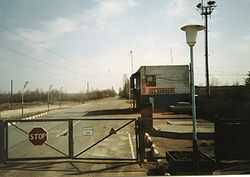
Brief visits to the Zone are possible through guided day-tours available to the public from Kiev or by applying directly to the Zone administration department. Some evacuated residents of Pripyat, Chernobyl and smaller villages have established a remembrance tradition, which includes annual visits to former homes and schools.[17] In the Chernobyl Zone, there is one operating Eastern Orthodox Christian church, St. Elijah Church, notable for its very low radiation levels, which, according to Chernobyl disaster liquidators, are "well below the level across the zone", a fact that president of the Ukrainian Chernobyl Union, Yury Andreyev, considers miraculous.[18][19]
The Chernobyl Exclusion Zone has been accessible to interested parties such as scientists and journalists since the Zone was created. An early example was Elena Filatova's online account of her alleged solo bike ride through the Zone. This gained her internet fame, but was later alleged to be fictional, as a guide claimed Filatova was part of an official tour group. Regardless, her story drew the attention of millions to the nuclear catastrophe.[20] After Filatova's visit in 2004, a number of papers such as The Guardian[21] and the New York Times[22] began to produce reports on tours to the Zone. Since then there have been growing numbers of visitors each year and there are now daily trips from Kiev; multi-day excursions can easily be arranged with Ukrainian tour operators.
Tourism to the area became more common after Pripyat was featured in popular video games: S.T.A.L.K.E.R.: Shadow of Chernobyl and Call Of Duty 4: Modern Warfare. Fans of the S.T.A.L.K.E.R. franchise gain access to the Zone and refer to themselves as "stalkers".[23] Prosecution of trespassers became more severe after a significant increase in trespassing in the Exclusion Zone. An article in the Penal Code of Ukraine was specially introduced,[24][25] and horse patrols were added to protect the Zone's perimeter.
In 2012, journalist Andrew Blackwell published Visit Sunny Chernobyl: And Other Adventures in the World's Most Polluted Places. Blackwell recounts his visit to the Exclusion Zone, when a guide and driver took him through the zone and to the reactor site.[26]
On 14 April 2013, the 32nd episode of the wildlife documentary TV program River Monsters (Atomic Assassin, Season 5, Episode 2) was broadcast featuring the host Jeremy Wade catching a wels catfish in the cooling pools of the Chernobyl power plant, at the heart of the Exclusion Zone.
On 16 February 2014, an episode of the British motoring TV programme Top Gear was broadcast featuring two of the presenters, Jeremy Clarkson and James May, driving into the Exclusion zone.
Illegal activities
The poaching of game, illegal logging, and metal salvage have been problems within the zone.[27] Despite police control, intruders started infiltrating the perimeter to remove potentially contaminated materials, from televisions to toilet seats, especially in Pripyat, where the residents of about 30 high-rise apartment buildings had to leave all of their belongings behind. In 2007, the Ukrainian government adopted more severe criminal and administrative penalties for illegal activities in the alienation zone,[28] as well as reinforced units assigned to these tasks. The introduced Przewalski's horse population has apparently fallen since 2005, due to poaching.[29]
Management of the Zone
Administration
|
Державне агентство України з управління зоною відчуження | |
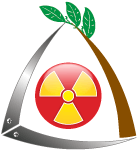 | |
| Agency overview | |
|---|---|
| Formed | April 6, 2011 |
| Preceding Agency | State Department - Administration of the exclusion zone and the zone of absolute (mandatory) resettlement |
| Jurisdiction | Government of Ukraine |
| Headquarters | Kiev and Chernobyl |
| Agency executive | Volodimir Ivanovich Kholosha, The Head |
| Parent department | State Emergency Service of Ukraine |
| Key document | Decree of the President of Ukraine № 393 of April 6, 2011 "On approval of the State Agency of Ukraine on the Exclusion Zone Management" |
| Website | http://dazv.gov.ua |
In April 2011 the State Agency of Ukraine on the Exclusion Zone Management (SAEZ) became the successor to the State Department - Administration of the exclusion zone and the zone of absolute (mandatory) resettlement according to presidential decree.[9] The SAEZ is, as its predecessor, an agency within the State Emergency Service of Ukraine. Policing of the Zone is conducted by special units of the Ministry of Internal Affairs of Ukraine and, along the border with Belarus, by the State Border Guard Service of Ukraine. It is partly excluded from regular civil rule. Any residential, civil or business activities in the zone are legally prohibited. The only officially recognized exceptions are the functioning of the Chernobyl nuclear power plant and scientific installations related to the studies of nuclear safety.
The SAEZ is tasked with the following:[9]
- Conducting environmental and radiation monitoring of the Zone;
- Management of long-term storage and disposal of radioactive wastes.
- Leases land in the Exclusion Zone and the Zone of absolute (mandatory) resettlement.
- Administrates the State Fund of radioactive wastes Management.
- Monitoring and preserving of documentation that describes the subject of radioactive wastes, warning signs, fences, etc.
- Coordinator of the decommissioning of Chernobyl Nuclear Power Plant.
- Oversees a register of persons suffered as a result of the Chernobyl disaster.
The decree also includes the task to "prevent corruption" (see corruption in Ukraine)
The Chernobyl nuclear power plant is located inside the Zone of Alienation but is administered separately. Plant personnel, 3,800 workers as of 2009, reside primarily in Slavutych, a specially-built remote city in the Kiev Oblast outside of the Exclusion Zone, 45 km (28 mi) east of the accident site.
Development and recovery projects
As of 2010 the Chernobyl Exclusion Zone is exclusively an environmental recovery area, with efforts devoted to remediation and re-enclosure of the reactor site. Environmental advocates have recommended making less-contaminated portions of the site permanently off limits to allow for wildlife recovery and a habitat reserve.[30]
The oldest and most recognized vision of the zone’s future is a research and industrial ground for developing nuclear technologies, including technology of nuclear wastes disposal. Permanent waste facilities are already being constructed in the zone, although these projects suffer from environmental and business concerns.
There are growing calls for wider economic and social revival of the territories around the disaster zone. For instance, special technologies are suggested for agriculture and energy projects that would avoid the danger of proliferating polluted material. The most vocal advocate of such revival was the then-President Viktor Yuschenko who has expressed his deep concerns with the exclusion of polluted territories from the society and economy of Ukraine.
In November 2007 the United Nations General Assembly adopted a resolution calling for "recovery and sustainable development" of the areas affected by the Chernobyl accident. Commenting on the issue, UN Development Programme officials mentioned the plans to achieve “self-reliance” of the local population, “agriculture revival” and development of eco-tourism.[31]
However, it is not clear whether such plans of UN and Yuschenko deal with the zone of alienation proper, or only with the other three zones around the disaster site where contamination is less intense and restrictions on the population looser (such as the district of Narodychi in Zhytomyrska Oblast).
For several years, tour operators have been bringing tourists inside the 30 km exclusion zone. Tourists are accompanied by tour guides at all times and are not able to wander too far on their own due to the presence of several radioactive "hot spots". Tourists can visit the abandoned town of Pripyat and view its overgrown streets. The International Atomic Energy Agency said that radioactivity in the area was tolerable to humans for a limited period.
Radioactive Contamination
The territory of the zone is polluted unevenly. Spots of hyperintensive pollution were created first by wind and rain spreading radioactive dust at the time of the accident, and subsequently by numerous burial sites for various material and equipment used in decontamination. Zone authorities pay attention to protecting such spots from tourists, scrap hunters and wildfires, but admit that some dangerous burial sites remain unmapped and known only by recollections of the liquidators.
Flora and fauna
There has been an ongoing scientific debate about the extent to which flora and fauna of the zone were affected by the radioactive contamination that followed the accident.
Near the facility, a dense cloud of radioactive dust killed off a large area of pine trees; the rusty-orange color of the dead trees led to the nickname "The Red Forest" (Рудий ліс). The Red Forest was among the world's most radioactive places. To reduce the hazard, the Red Forest was bulldozed and the highly irradiated wood was buried—though the soil continues to exude significant radiation.
Cases of mutant deformity in animals of the zone include partial albinism and other external malformations in swallows[32][33][34] and insect mutations.[35] A study of several hundred birds belonging to 48 different species also demonstrated that birds inhabiting highly radioactively contaminated areas had smaller brains compared to birds from clean areas.[36] There have been claims of other animal mutations from individual eyewitness reports, although none have been verified.
A reduction in the density and the abundance of animals in highly radioactively contaminated areas has been demonstrated for several taxa, including birds,[37][38] insects and spiders,[39] and mammals. [40] In birds, which are an efficient bioindicator, species diversity decreases 50 percent in radioactively contaminated areas compared to clean areas, while abundance decreases by two thirds.
There have been reports that wildlife has since flourished due to significant reduction of human impact.[41] For this reason, the Zone is considered by some as a classic example of an involuntary park. Some claim that the populations of traditional Polesian animals (such as wolves, badger, wild boar, roe deer, white-tailed eagle, black stork, Western marsh harrier, short-eared owl, red deer, moose, great egret, whooper swan, least weasel, common kestrel and beaver) have multiplied enormously and begun expanding outside the zone. These claims, however, are not substantiated by any systematic census of any animal taxon.[42]
The area also houses herds of wisent (European bison, native to the area) and Przewalski's horses (foreign to the area, as tarpan was the native wild horse) released there after the accident. Some accounts refer to the reappearance of extremely rare native lynx, and there are videos of brown bears and their cubs, an animal not seen in the area for more than a century. Special game warden units are organized to protect and control them. No scientific study has been conducted on the population dynamics of these species.
The rivers and lakes of the zone pose a significant threat of spreading polluted silt during spring floods. They are systematically secured by dikes.
Grass and forest fires
It is known that fires can make radioactivity mobile again.[43][44][45][46] In particular V.I. Yoschenko et al. reported on the possibility of increased mobility of caesium, strontium, and plutonium due to grass and forest fires.[47] As an experiment, fires were set and the levels of the radioactivity in the air downwind of these fires was measured.
Grass and forest fires have happened inside the contaminated zone, releasing radioactive fallout into the atmosphere. In 1986 a series of fires destroyed 2,336 ha (5,772 acres) of forest, and several other fires have since burned within the 30 km (19 mi) zone. A serious fire in early May 1992 affected 500 ha (1,240 acres) of land, including 270 ha (670 acres) of forest. This resulted in a great increase in the levels of caesium-137 in airborne dust.[43][48][49][50]
In 2010, a series of wildfires affected contaminated areas, specifically the surroundings of Bryansk and border regions with Belarus and Ukraine.[51] The Russian government claims that there has been no discernible increase in radiation levels, while Greenpeace accuses the government of denial.[51]
Infrastructure
The industrial, transport, and residential infrastructure has been largely crumbling since the 1986 evacuation. There are at least 800 known "burial grounds" (Ukrainian singular: mohyl'nyk) for the contaminated vehicles with hundreds of abandoned military vehicles and helicopters. River ships and barges lie in the abandoned port of Chernobyl. The largest "vehicle graveyard" was dismantled recently and no longer exists, but the port of Chernobyl can easily be seen in satellite images of the area.[52]
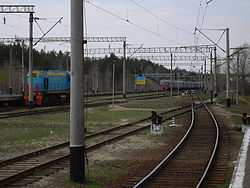
However, the infrastructure immediately used by the existing nuclear-related installations is maintained and developed, such as the railway link to the outside world from the Semykhody station used by the power plant.
"Chernobyl-2"
The Chernobyl-2 site (a.k.a. "The Russian Woodpecker") is a former Soviet military installation relatively close to the power plant, consisting of a gigantic transmitter and receiver belonging to the Duga-3 over-the-horizon radar system.[53] The secrecy around this unit once provoked a rumour that it was the real cause of the disaster. According to Ukrainian TV, the base is now defunct and handed over to the Ministry of Emergencies. The rusting iron superstructures of the station are being considered for dismantling over the fears of their accidental collapse which would cause a microearthquake damaging the radioactive storage in the area.
Located 2 km from the surface area of Chernobyl-2 is a large underground complex that was used for anti-missile defense, space surveillance and communication, and research.[54] Military units were stationed there.[54]
Media depictions
In 2011 Guillaume Herbaut and Bruno Masi created the webdocumentary La Zone, funded by CNC, LeMonde.fr and Agat Films. The documentary explores the communities and individuals that still inhabit or visit the exclusion zone.[55]
The 2012 film Chernobyl Diaries is set in the exclusion zone. The horror movie follows a tour group that become stranded in Pripyat, and their encounters with creatures mutated by radioactive exposure.[56]
The PBS program Nature aired on October 19, 2011 its documentary Radioactive Wolves which explores the return to nature which has occurred in the exclusion zone among wolves and other wildlife.[57]
The video game series S.T.A.L.K.E.R. recreates parts of the Zone from source photographs and in-person visits (bridges, railways, buildings, compounds, abandoned vehicles), albeit taking some artistic license regarding the geography of the Zone for gameplay reasons.[58]
See also
- Chernobyl after the disaster
- List of Chernobyl-related articles
- Ministry of Emergencies (Ukraine)
References
- ↑ 1.0 1.1 "Чернобыльскую зону "захватывают" самоселы". Ura-inform.com. 2012-08-28. Retrieved 2012-10-22.
- ↑ 2.0 2.1 "Секреты Чернобыля - "Самоселы"". Chernobylsecret.my1.ru. Retrieved 2012-10-22.
- ↑ "ORDER MOE of Ukraine on November 2, 2011 № 1157 approving the visiting of the exclusion zone and zone of unconditional (mandatory) resettlement". 2 November 2011. Retrieved 23 April 2012.
- ↑ 4.0 4.1 4.2 4.3 4.4 Petryna, Adriana (2002). Life Exposed: Biological Citizens after Chernobyl publisher=Princeton University Press. New Jersey. ISBN 978-0-691-09019-1.
- ↑ 5.0 5.1 5.2 5.3 5.4 Marples, David R. (1988). The Social Impact of the Chernobyl Disaster. New York: St. Martin's Press. ISBN 0-312-02432-0.
- ↑ 6.0 6.1 6.2 6.3 Mould, R. F. (2000). Chernobyl Record: The Definitive History of the Chernobyl Catastrophe. Bristol, UK: Institute of Physics Publishing. ISBN 0-7503-0670-X.
- ↑ 7.0 7.1 7.2 7.3 7.4 Bondarkov, Mikhail D.; Boris Ya. Oskolkov; Sergey P. Gaschak; Sergey I. Kireev; Andrey M. Maksimenko; Nikolai I. Proskura; G. Timothy Jannik (2011). Environmental Radiation Monitoring in the Chernobyl Exclusion Zone - History and Results 25 Years After. US: Savannah River National Laboratory / Savannah River Nuclear Solutions.
- ↑ 8.0 8.1 "Zoning of radioactively contaminated territory of Ukraine according to actual regulations". ICRIN. 2004. Retrieved 25 April 2012.
- ↑ 9.0 9.1 9.2 "Decree of the President of Ukraine № 393/2011 On approval of the State Agency of Ukraine of the Exclusion Zone". 6 April 2011. Retrieved 23 April 2012.
- ↑ "Postcard from hell". The Guardian. 18 October 2004. Retrieved 25 April 2012.
- ↑ International Atomic Energy Agency. "IAEA Frequently Asked Chernobyl Questions". Retrieved 23 April 2012.
- ↑ Nasvit, O. (1998). "Legislation in Ukraine about the Radiological Consequences of the Chernobyl Accident". Research Activities abtou the Radiological Consequences of the Chernobyl NPS Accideent and Social Activities to Assist the Sufferers by the Accident, KURRI-KR-21, Research Reactor Institute, Kyoto University 注 25: 51–57.
- ↑ "IAEA's Power Reactor Information System polled in May 2008 reports shut down for units 1, 2, 3 and 4 respectively". Retrieved 25 April 2012.
- ↑ URA-Inform (28 August 2012). "ChernobylZone squatter captured". URS-Inform. Retrieved 11 December 2012.
- ↑ 15.0 15.1 15.2 Marples, David (May 3, 2012). "Chornobyl's legacy in Ukraine: Beyond the United Nations reports". Kyiv Post. Retrieved 11 December 2012.
- ↑ Rothbart, Michael. "After Chernobyl". Retrieved 11 December 2012.
- ↑ pripyat.com Community website for the ghost city of Pripyat
- ↑ "The only church open in Chernobyl zone shows the minimum radiation level". Interfax. 20 April 2011. Retrieved 29 April 2014.
Kiev, April 20, Interfax - During 25 years from the date of Chernobyl accident the radiation level in the area of St. Elijah Church, the only church operating in the exclusion zone, was well below the level across the zone, Chernobyl disaster liquidators state. "Even in the hardest days of nineteen eighty six the area around St. Elijah Church was clean (from radiation - IF), not to mention that the church itself was also clean," president of the Ukrainian Chernobyl Union Yury Andreyev said in a Kiev-Moscow video conference on Wednesday. Now the territory adjacent to the church has the background level of 6 microroentgen per hour compared with 18 in Kiev. Andreyev also said many disaster liquidators had been atheists. "We came to believe later after observing such developments which could be explained only by God's will," he says.
- ↑ "The only church open in Chernobyl zone shows the minimum radiation level". Kiev: Pravoslavie. 21 April 2011. Retrieved 29 April 2014.
- ↑ "Account of Chernobyl Trip Takes Web Surfers for a Ride", by Mary Mycio Los Angeles Times, July 6, 2004
- ↑ Postcard from hell - UK Guardian
- ↑ New Sight in Chernobyl's Dead Zone: Tourists, New York Times
- ↑ Yourself stalker in Russian (The investigation of a journalist on the problem of Chernobyl stalking in the exclusion zone)
- ↑ http://zakon.rada.gov.ua/cgi-bin/laws/main.cgi?page=7&nreg=2341-14 introduced criminal article 267-1 of the Penal Code
- ↑ http://zakon.rada.gov.ua/cgi-bin/laws/main.cgi?page=2&nreg=80731-10 Penal Code
- ↑ Blackwell, Andrew (2012). Visit Sunny Chernobyl: And Other Adventures in the World's Most Polluted Places. Rodale Books. p. 320. ISBN 978-1-60529-445-2.
- ↑ Davies. T & Polese A. (2015) 'Informality and survival in Ukraine's nuclear landscape: Living with the risks of Chernobyl' Journal of Eurasian Studies. Vol. 6 No. 1 p.34-45 https://www.academia.edu/9950719/Informality_and_survival_in_Ukraines_nuclear_landscape_Living_with_the_risks_of_Chernobyl
- ↑ Chernobyl Souvenir Hunters May Become Convicts
- ↑ http://www.bbc.co.uk/nature/14277058
- ↑ Baker, Robert J. and Chesser, Roland K. "The Chernobyl Nuclear Disaster And Subsequent Creation of a Wildlife Preserve". Environmental Toxicology and Chemistry, Vol.19, No.5, pp.1231-1232, 2000. Retrieved 2010-08-14.
- ↑ UN plots Chernobyl zone recovery BBC news, Nov 21, 2007
- ↑ Møller, A P; T A Mousseau (2001). "Albinism and phenotype of barn swallows (Hirundo rustica) from Chernobyl". Evolution; International Journal of Organic Evolution 55 (10): 2097–2104. doi:10.1554/0014-3820(2001)055[2097:aapobs]2.0.co;2. ISSN 0014-3820. PMID 11761068.
- ↑ Møller, A P; T A Mousseau; F de Lope; N Saino (2007). "Elevated frequency of abnormalities in barn swallows from Chernobyl". Biology Letters 3 (4): 414–417. doi:10.1098/rsbl.2007.0136. ISSN 1744-957X. PMC 1994720. PMID 17439847.
- ↑ Chernobyl 'not a wildlife haven' , by Mark Kinver, BBC News
- ↑ Field studies in the nuclear fallout areas from Chernobyl by Cornelia Hesse-Honegger
- ↑ Møller, A P; A Bonisoli-Alquati; G Rudolfsen; T A Mousseau (2011). "Chernobyl birds have smaller brains". PLoS ONE 6 (2): e16862. doi:10.1371/journal.pone.0016862. ISSN 1932-6203. PMC 3033907. PMID 21390202. Retrieved 2012-02-07.
- ↑ Møller, A P; T A Mousseau (2007). "Species richness and abundance of forest birds in relation to radiation at Chernobyl". Biology Letters 3 (5): 483–486. doi:10.1098/rsbl.2007.0226. ISSN 1744-957X. PMC 2394539. PMID 17698449. Retrieved 2012-02-01.
- ↑ Møller, A P; T A Mousseau (2009). "Reduced abundance of raptors in radioactively contaminated areas near Chernobyl". Journal of Ornithology 150 (1): 239–246. doi:10.1007/s10336-008-0343-5. ISSN 2193-7206.
- ↑ Møller, A P; T A Mousseau (2009). "Reduced abundance of insects and spiders linked to radiation at Chernobyl 20 years after the accident". Biology Letters 5 (3): 356–359. doi:10.1098/rsbl.2008.0778. ISSN 1744-957X. PMC 2679916. PMID 19324644. Retrieved 2012-02-01.
- ↑ Møller, A P; T A Mousseau (2011). "Efficiency of bio-indicators for low-level radiation under field conditions". Ecological Indicators 11 (2): 424–430. doi:10.1016/j.ecolind.2010.06.013. ISSN 1470-160X.
- ↑ Wildlife defies Chernobyl radiation, by Stefen Mulvey, BBC News
- ↑ Møller, A P; T A Mousseau; F de Lope; N Saino (2008). "Anecdotes and empirical research in Chernobyl". Biology Letters 4 (1): 65–66. doi:10.1098/rsbl.2007.0528. ISSN 1744-957X. PMC 2412943. Retrieved 2012-02-07.
- ↑ 43.0 43.1 Dusha-Gudym, Sergei I. (August 1992). "Forest Fires on the Areas Contaminated by Radionuclides from the Chernobyl Nuclear Power Plant Accident". IFFN. Global Fire Monitoring Center (GFMC). pp. No. 7, p. 4–6. Retrieved 2008-06-18.
- ↑ http://www.maik.ru/abstract/radchem/4/radchem0102_abstract.pdf PDF (5.07 KB)
- ↑ Davidenko, Eduard P.; Johann Georg Goldammer (January 1994). "News from the Forest Fire Situation in the Radioactively Contaminated Regions".
- ↑ Antonov, Mikhail; Maria Gousseva (2002-09-18). "Radioactive fires threaten Russia and Europe". Pravda.ru.
- ↑ Yoschenko et al. (2006). Journal of Environmental Radioactivity 86: 143–163. doi:10.1016/j.jenvrad.2005.08.003. Missing or empty
|title=(help) - ↑ Transport of Radioactive Materials by Wildland fires in the Chernobyl Accident Zone: How to Address the Problem PDF (416 KB)
- ↑ Chernobyl Forests. Two Decades After the Contamination PDF (139 KB)
- ↑ Allard, Gillian. "Fire prevention in radiation contaminated forests". Forestry Department, FAO. Retrieved 2008-06-18.
- ↑ 51.0 51.1 Deutsche Welle (August 11, 2010). "Russian fires hit Chernobyl-affected areas, threatening recontamination".
- ↑ Exploring The Chernobyl Dead Zone With Google Maps
- ↑ Photogallery of the Chernobyl-2 radar installation at pripyat.com
- ↑ 54.0 54.1 Wolfgang Spyra. Environmental Security and Public Safety. Springer, Mar 6, 2007. pg. 181
- ↑ http://www.lemonde.fr/week-end/visuel/2011/04/22/la-zone-retour-a-tchernobyl_1505079_1477893.html
- ↑ http://www.imdb.com/title/tt1991245/
- ↑ http://video.pbs.org/video/2157025070/
- ↑ http://www.stalker-game.com/en/?page=dev_diary&item=3
External links
| Wikimedia Commons has media related to Chernobyl Exclusion Zone. |
| Wikivoyage has a travel guide for Chernobyl. |
- State Agency of Ukraine in Management of the Exclusion Zone website
- Ministry of Emergencies website
- Vegetative life in Chernobyl zone of alienation
News and publications
BBC's ongoing coverage
- Chernobyl's legacy recorded in trees by the BBC
- Chernobyl mammals tracked in snow by the BBC
- Wildlife defies Chernobyl radiation - by BBC News, 20 April 2006
Other reliable sources
- Radioactive Wolves - by PBS Documentary aired in the U.S. on Oct, 19 2011
- Picnic in the Death Zone - TV Documentary following Chernobyl scientists as they hunt for radioactive animals deep in the alienation zone
- Inside the Forbidden Forests 1993 The Guardian article about the zone
- The zone as a wildlife reserve
Images from inside the Zone
- Touring Chernobyl 25 Years Later
- Images of the exclusion zone and the abandoned city of Pripyat
- Panoramio.com - photos from Panoramio users
- Images from inside the Zone
- More images from inside the Zone
- Tour of the Zone in 2005
- 2008/09 Images and experiences from the zone
- The Lost City of Chernobyl Photos
- Wildlife photos of Chernobyl Exclusion zone - Exploration of polluted territory.
- Slide show of a visit to the Zone in April 2006 by a German TV team joint by Research Center Juelich
- A story of a motorcyclist riding through the zone by Elena Filatova with pictures taken during guided bus tour through the zone. - November 2004
- Chernobyl Tour and Pripyat Ghost Town
| ||||||||||||||||||||||||||||||||||||||||||||
